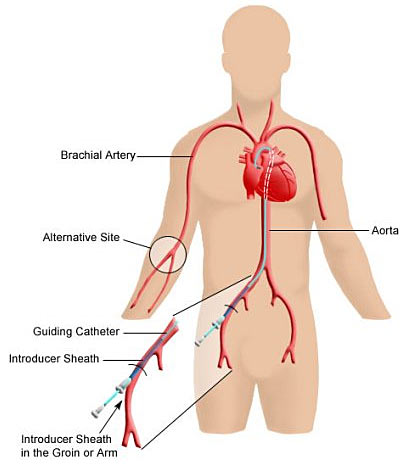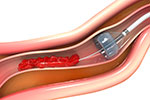Cardiac Catheterization Laboratory (Cath Lab)
The cardiac catheterization procedure itself involves threading a long, thin tube, called a catheter, through an artery or vein in the leg or arm and into the heart. Sometimes a cardiac catheterization is performed due to an emergency such as a heart attack in progress. Other times, a cardiac catheterization, also known as an angiogram, is performed as a diagnostic tool to check for blockages if your physician suspects you may have coronary artery disease.
 STEMIs are caused by a sudden blockage in a coronary artery and recent studies have indicated that rapid cardiac intervention is the most effective treatment for saving the heart muscle. Patients may be brought into the cardiac
cath lab 24 hours a day, 7 days a week where these blockages can be immediately opened by using a balloon catheter and/or implanted stent.
STEMIs are caused by a sudden blockage in a coronary artery and recent studies have indicated that rapid cardiac intervention is the most effective treatment for saving the heart muscle. Patients may be brought into the cardiac
cath lab 24 hours a day, 7 days a week where these blockages can be immediately opened by using a balloon catheter and/or implanted stent.Routine procedures at San Antonio Regional Hospital’s Cardiac Catheterization Lab are scheduled weekdays, from 7:30 am to 6:00 pm, by your physician's office staff. Emergency cardiac diagnostic, interventional, and therapeutic procedures are available at all times.
Cardiac Catheterization/Angiogram
Interventional Procedures
An interventional procedure starts out in the same way as a diagnostic cardiac catheterization or angiogram. The catheter will be selectively passed into the artery with the blockage, and the doctor will perform the interventional procedure to open the blocked artery. The procedure usually lasts about 1-1/2 to 2-1/2 hours, but the preparation add additional time. An overnight stay is sometimes required.
Balloon Angioplasty
 During angioplasty in the cardiac catheterization lab, the interventional cardiologist will use a special catheter with a small angioplasty balloon attached at the end. The balloon is at one end and can be inflated
from the other end outside the body. A physician trained in interventional cardiology then threads the balloon catheter over a guidewire to the area of the artery that has become blocked with the fatty substance called plaque. Plaque is
what prevents your blood from flowing as it should. The balloon is inflated and deflated several times to compress the plaque or fatty matter in the artery wall and stretch the artery open to increase blood flow in the artery in the heart.
During angioplasty in the cardiac catheterization lab, the interventional cardiologist will use a special catheter with a small angioplasty balloon attached at the end. The balloon is at one end and can be inflated
from the other end outside the body. A physician trained in interventional cardiology then threads the balloon catheter over a guidewire to the area of the artery that has become blocked with the fatty substance called plaque. Plaque is
what prevents your blood from flowing as it should. The balloon is inflated and deflated several times to compress the plaque or fatty matter in the artery wall and stretch the artery open to increase blood flow in the artery in the heart.
Stent

A stent is used along with balloon angioplasty in the cardiac catheterization laboratory. A stent is a small, metal mesh tube that is delivered through a catheter to the site of a blocked artery and then permanently embedded within the artery. A stent acts as a tiny scaffold to prop an artery open and prevent it from collapsing or becoming re-blocked with plaque.
Rotoblation
 A rotoblation procedure is performed in the cardiac catheterization lab. During rotoblation, a special catheter, with an acorn-shaped diamond-coated tip, is guided to the point of narrowing in the coronary artery. The
tip spins around at a high rate of speed and grinds away the plaque that has built up on your artery walls and narrowed your artery. The microscopic particles are washed safely away in your blood stream and filtered out by your liver and spleen.
A rotoblation procedure is performed in the cardiac catheterization lab. During rotoblation, a special catheter, with an acorn-shaped diamond-coated tip, is guided to the point of narrowing in the coronary artery. The
tip spins around at a high rate of speed and grinds away the plaque that has built up on your artery walls and narrowed your artery. The microscopic particles are washed safely away in your blood stream and filtered out by your liver and spleen.
Cutting Balloon
Pacemaker

- A pulse generator, which includes the battery and several electronic circuits.
Wires, called leads, which are attached to the heart wall. Depending on the type of pacemaker you need, there may be one or two leads.
Once the pacemaker is implanted, the leads carry signals back from the heart. The pulse generator "reads" these signals. When the heart rate is too slow, it sends an impulse to the heart to help beat in a regular rhythm.
PAD Treatment
Vascular diseases such as Peripheral Artery Disease (PAD) may also be treated in the San Antonio Regional Hospital Cardiac Catheterization Lab by interventional cardiologists. Using imaging for guidance, the cardiologists thread a catheter through the femoral artery in the groin, to the blocked artery in the legs. Then a balloon is inflated to open the blood vessel where it is narrowed or blocked. In some cases, this is then held open with a stent, a tiny metal cylinder. This is a minimally invasive treatment that does not require surgery, just a small opening in the skin about the size of a pencil tip.
